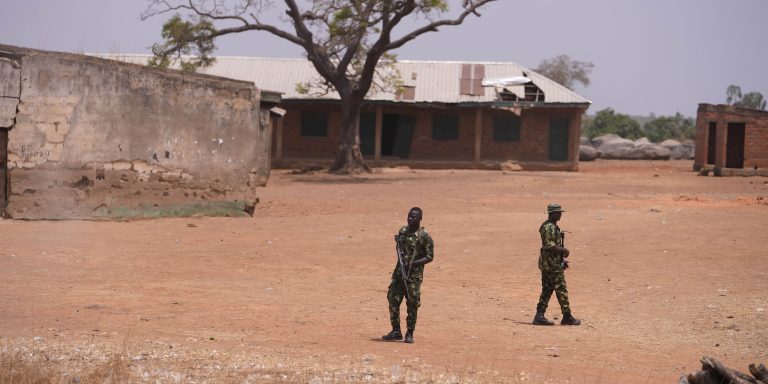
Security in northwestern Nigeria is deteriorating, with an estimated 30,000 bandits operating in loosely organized groups that have evolved from resource disputes into actors capable of mass abductions and high-casualty attacks.
Zamfara State is the epicenter of violence, where armed groups exploit gold, copper, and lithium deposits to fund operations and sustain arsenals through trafficking routes and raids on state armories.
Jihadist factions centered in the northeast — including JAS, ISWAP, and Ansaru — are increasingly embedded within local conflicts, leveraging transactional cooperation with bandit groups to extend influence into the northwest.
Northwestern Nigeria’s long and porous border with Niger provides militants with critical access to Sahelian smuggling corridors, heightening the risk of cross-border jihadist cooperation and further destabilization of the region.
Security in northwestern Nigeria is deteriorating rapidly amid a surge of violent, coordinated attacks by a host of non-state armed groups. The theater of conflict in northwestern Nigeria exhibits a distinct hybrid security landscape where criminal economies, communal grievances, and jihadist insurgency converge, blurring distinctions between organized crime and ideology. The crisis — characterized by criminal insurgency, warlordism, and intercommunal violence, and commonly subsumed under the broad label of “banditry” — has drastically escalated over the past several month. More recently, on August 19, armed gunmen stormed a mosque in Katsina State, killing at least 30 worshippers. Earlier that month, on August 3, bandits abducted 50 people in Zamfara State during a single coordinated attack. The previous month, gunmen killed at least six people and abducted more than 100 others in an assault on the Kairu community in Zamfara. The threat level is rising; according to Reuters, in the first half of 2025 at least 2,266 people were killed by insurgents or armed bandits — surpassing the total number of casualties for all of 2024.
At the heart of this crisis lies Zamfara State: mineral-rich with deposits of gold, copper, and lithium, but also one of Nigeria’s most insecure regions. According to Amnesty International, since 2023 more than 273 people have been killed and 467 have been abducted in Zamfara. Approximately 725 villages across 13 local government areas remain under the control of bandits. In an effort to disrupt the embedded presence of bandits in the region — on August 12, following intelligence of an imminent attack by over 400 gang members, the Nigerian military launched air and ground raids in Zamfara, reportedly killing 100 bandits and several gang leaders. Yet weak state authority and a thin security presence in rural areas continue to undermine stability. Moreover, the Nigerian military — also grappling with structural issues such as corruption — remains stretched thin by the simultaneous jihadist insurgency in the northeast where some 35,000 civilians have been killed and more than 2 million displaced, according to the UN. Beyond the northeast, Jama’atu Ahlis-Sunna Lidda’Awati Wal-Jihad (JAS) — also known as ‘Boko Haram’ — has entrenched itself through its Shiroro cell — an enclave of JAS operating in the Shiroro Local Government Area (LGA) — in Niger State, near Abuja, representing the furthest and most successful expansion of Boko Haram outside the Lake Chad Basin. The Nigerian security apparatus is overextended — fighting on multiple fronts across two-thirds of the country — combined with endemic corruption and inadequate troop welfare, which has combined to create structural vulnerabilities that jihadist and bandit actors are actively exploiting.
Banditry has emerged as the principal security challenge in the northwest. It is estimated that approximately 30,000 bandits are spread across numerous groups, ranging in size from small gangs to formations of more than a thousand fighters. The majority of these groups draw their membership from Fulani herdsmen, a constituency long subject to grievances and one that jihadist factions such as Jama’at Nasr al-Islam wal-Muslimin (JNIM) and Islamic State Greater Sahara (ISGS) have heavily targeted for recruitment in the Sahel. Bandits have displayed increasingly sophisticated capabilities, staging mass kidnappings, raiding villages, and carrying out large-scale cattle rustling — providing significant financial returns in the impoverished countryside. Despite sustained military deployments against criminal gangs since 2015 and the creation of a state-backed militia force in Zamfara two years ago, violence has continued unabated.
Jihadist groups — JAS, Islamic State West Africa Province (ISWAP), and Ansaru — whose primary areas of operation have traditionally centered on the northeast, particularly Borno State and the Lake Chad Basin, have made sustained efforts to expand into the northwest and central states. A smaller JAS-affiliated faction, the Sadiku group, is already active in the region, with operations concentrated between Niger and Kaduna States.
ISWAP, in particular, has emerged as the Islamic State’s (IS) most prolific affiliate globally. Between July 2024 and July 2025, it led all IS “provinces” worldwide with 445 claimed attacks and 1,552 reported casualties. Since April 2025, ISWAP has intensified its “burn the camps” campaign in the Lake Chad Basin, systematically targeting Nigerian military positions. This has exposed the vulnerabilities of the “super camp” approach, whereby the military consolidated smaller outposts into larger bases to counter extremist threats. While intended to strengthen defenses, the strategy has instead left vast rural areas exposed and created lucrative targets that insurgents have repeatedly exploited.
These developments not only highlight the strength of ISWAP but also underscore the dual effect of undermining military responses to other crises afflicting northern Nigeria — including the issue of banditry, which is increasingly intersecting with jihadist activity. Jihadist groups have recruited bandits to their cause, at times entering into ad hoc transactional arrangements. This has produced a fraught and fluid nexus between jihadist insurgents and criminal networks, enabling extremists to establish enclaves in the northwest.
Militant convergence has significantly amplified the threat environment. Jihadist factions — including al-Qaida-affiliated Ansaru and elements of ISWAP — have cultivated pragmatic alliances with bandit networks, providing tactical training, ideological framing, and weapons in exchange for guarantees of safe passage and access to resources. This convergence has expanded operational reach and embedded extremist influence within local conflicts.
The Mali-based Lakurawa network exemplifies this intersection between terrorism and banditry in Nigeria. A Fulani-rooted armed group designated a terrorist organization by Abuja in 2025 with links to the Islamic State Sahel Province (ISSP), Lakurawa fighters carried out a string of attacks between January and June 2025 across Sokoto and Kebbi States, killing 59 civilians, clashing with security forces, and targeting communications infrastructure. Reports indicate growing ties with JAS, with Boko Haram militants reinforcing Lakurawa operations. This blending of networks suggests the northwest may develop into a second insurgency theater alongside the northeast.
Geography further heightens these risks. Niger State serves as a gateway between northern and southern Nigeria and shares porous forested borders with Benin that connect directly to the Sahel. These corridors facilitate arms trafficking, smuggling, and militant movement. Against this backdrop, the Shiroro cell, the Lakurawa network, and entrenched bandit formations are collectively driving the northwest toward consolidation as an insurgent hub — mirroring the Lake Chad crisis, but with dangerous proximity to Abuja.
Regional geopolitics have compounded these dynamics. Relations between Nigeria and Lake Chad states — including Cameroon, Chad, and Niger — have frayed since Niger’s 2023 coup. Nigerian President Bola Tinubu’s initial hardline stance against the junta created enduring diplomatic ruptures. The Nigeria–Niger border remained closed for an extended period, and Niamey suspended its participation in the Multinational Joint Task Force (MNJTF), undermining a key framework for regional counterterrorism cooperation. This weakening of the MNJTF — already strained by Niger’s withdrawal and Chad’s wavering commitment — has further reduced cross-border coordination, leaving militant actors more room to maneuver. As such, the possibility of Nigerian jihadists linking their emerging northwestern bases with Sahelian networks — creating both geographic continuity and expanded cooperation — is now more acute than ever before.
